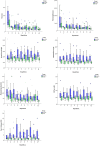Haptic exploration improves performance of a laparoscopic training task
- PMID: 32875419
- PMCID: PMC8263408
- DOI: 10.1007/s00464-020-07898-6
Haptic exploration improves performance of a laparoscopic training task
Abstract
Background: Laparoscopy has reduced tactile and visual feedback compared to open surgery. There is increasing evidence that visual and haptic information converge to form a more robust mental representation of an object. We investigated whether tactile exploration of an object prior to executing a laparoscopic action on it improves performance.
Methods: A prospective cohort study with 20 medical students randomized in two different groups was conducted. A silicone ileocecal model, on which a laparoscopic action had to be performed, was used inside an outside a ForceSense box trainer. During the pre-test, students either did a combined manual and visual exploration or only visual exploration of the caecum model. To track performance during the trials of the study we used force, motion and time parameters as representatives of technical skills development. The final trial data were used for statistical comparison between groups.
Results: All included time and motion parameters did not show any clear differences between groups. However, the force parameters Mean force non-zero (p = 004), Maximal force (p = 0.01) Maximal impulse (p = 0.02), Force volume (p = 0.02) and SD force (p = 0.01) showed significant lower values in favour of the tactile exploration group for the final trials.
Conclusions: By adding haptic sensation to the existing visual information during training of laparoscopic tasks on life-like models, tissue manipulation skills improve during training.
Keywords: Box trainer; ForceSense; Haptics; Laparoscopy training; Tactile exploration.
Conflict of interest statement
Applied Medical Europe, The Netherlands provided the anatomical models used in this research free of charge. Applied Medical Europe BV had no role in the study design, collection, analysis and interpretation of data, the writing of this report, and the decision to submit the article for publication. MediShield BV provided a ForceSense.Net research account to conduct, store and analyse the data in this study. The support did not create a conflict of interest regarding all parts of the study. Roelf Postema, Leonie van Gastel, Sem Hardon, Jaap Bonjer and Tim Horeman declare no conflicts of interest.
Figures




References
Publication types
MeSH terms
LinkOut - more resources
Full Text Sources

